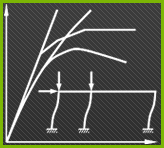




The nonlinear analysis capabilities of MASTAN2 provide students the opportunity to perform a wide range of investigations into the behavior of structural members and systems. With this in mind, the below learning modules are intended for use in undergraduate and/or graduate level steel design or structural stability courses. Of course, practicing engineers are also encouraged to continue their education by completing these exercises.
Although the modules can be completed with MASTAN2, they have been prepared in generic form so that other nonlinear analysis software could be employed. Each module is provided as PDF and Microsoft Word files along with accompanying Microsoft Excel spreadsheets. In addition to instructions, questions, and suggestions for further study, these files include links to videos that show MASTAN2 in action. For those employing MASTAN2, completion of at least one Tutorial is strongly encouraged before attempting the below modules. Enjoy!
ANSI/AISC 360-16
- Specification for Structural Steel Buildings and Commentary (2016):
In several places within the below learning modules the AISC Specification and Commentary are referenced.
[Click here for more details.] and [Click here to download.]
Learning Module 1
- Elastic Column Buckling and the Effect of End Restraint:
Using a critical load analysis, the elastic flexural buckling strength of a column with various degrees of end restraint is investigated.
[Click here for more details.] and [Click here to download module.]
Learning Module 2
- Factors Influencing the Flexural Buckling Strength of Compression Members:
Using computational analysis as a virtual laboratory, the main factors that impact the flexural buckling strength of steel wide-flange sections with nonslender elements are investigated. These factors include member slenderness, material nonlinearity, initial imperfections in geometry (out-of-straightness), and residual stresses. Computed strengths are presented in the form of column curves, which are further compared with the corresponding nominal strength curve defined in Chapter E of the AISC Specification for Structural Steel Buildings (2016).
[Click here for more details.] and [Click here to download module.]
Learning Module 3
- Effective Length K-factors for Frame Members:
Effective length K-factors for compression members in frames are investigated. In addition to studying cases of sidesway inhibited and unhibited, elastic and inelastic buckling is explored. Computational results are compared with alignment chart methods.
[Click here for more details.] and [Click here to download module.]
Learning Module 4
- Factors Influencing the Strength of Flexural Members:
Using computational analysis as a virtual laboratory, the main factors that impact the major-axis flexural strength of steel wide-flange sections with compact elements are investigated. These factors include unbraced length, partial yielding accentuated by the presence of residual stresses, and initial imperfections in geometry (out-of-straightness). Strength limit states defined by full yielding of the cross-section (plastic hinge) and elastic/inelastic lateral torsional buckling are studied. Computed strengths are presented in the form of beam strength curves, which are further compared with the corresponding nominal strength curve defined in Chapter F of the AISC Specification for Structural Steel Buildings (2016).
[Click here for more details.] and [Click here to download module.]
Learning Module 5
- Lateral-Torsional Buckling of Beams with Moment Gradient:
The influence of moment gradient on the lateral-torsional buckling capacity of compact wide-flange beams is studied. Equivalent uniform moment factors Cb back-calculated from computational analyses are compared with values computed using two longstanding equations, one appearing in Chapter F of the AISC Specification for Structural Steel Buildings (2016) and the other in the Commentary to the Specification.
[Click here for more details.] and [Click here to download module.]
Learning Module 6
- Beam Design by Elastic and Inelastic Analyses:
The design of a laterally braced beam of compact section is investigated using elastic and inelastic analyses. In addition to observing differences in load carrying capacity and efficiency, force and moment redistribution as a result of member yielding is explored.
[Click here for more details.] and [Click here to download module.]
Learning Module 7
- Second-order (P-Δ and P-δ) Effects:
Second-order effects in beam-columns are investigated. Results obtained using rigorous second-order elastic analyses are compared with approximate moment amplification factors. Both P-Δ and P-δ effects are observed.
[Click here for more details.] and [Click here to download module.]
Learning Module 8
- Strength of Beam-Columns:
The strength of beam-columns is investigated for various combinations of axial force and bending moment. Both major- and minor-axis flexure of steel wide-flange sections with compact elements are investigated. Nominal strength curves per requirements of Chapter H of the AISC Specification for Structural Steel Buildings (2016) are compared with results obtained using second-order inelastic analyses. Strength limit states defined by elastic/inelastic flexural and lateral torsional buckling as well as full yielding of the cross-section (plastic hinge) are studied.
[Click here for more details.] and [Click here to download module.]
Learning Module 9
- Design by the Direct Analysis Method:
The design of a portal frame is investigated for two options available within the Direct Analysis Method as defined in Chapter C of the AISC Specification for Structural Steel Buildings (2016). Rigorous second-order analyses are employed to check the adequacy of compact doubly symmetric members subject to flexure and axial force.
[Click here for more details.] and [Click here to download module.]
Overview Presentation
- AISC Educator Session:
On 18-April-2012, I had the pleasure of presenting an overview and some background to these modules at AISC’s North American Steel Construction Conference in Grapevine, TX. AISC recorded this presentation and make it available at their website. The links below provide access to my slides.
[Click here for more details.] and [Click here to download file.]
Special thanks to Nick Noss and my CENG405:Design of Steel Structures classes for taking these learning modules on thorough test drives. -R.D. Ziemian
